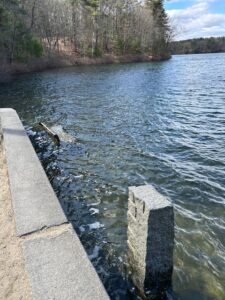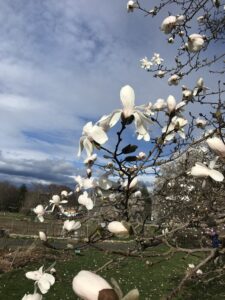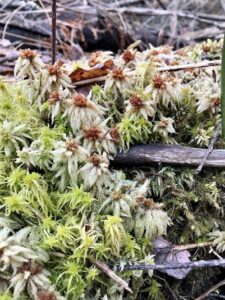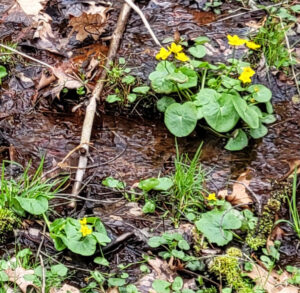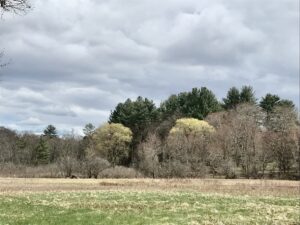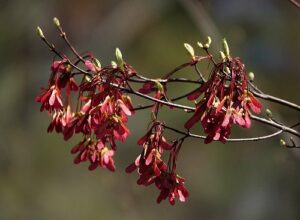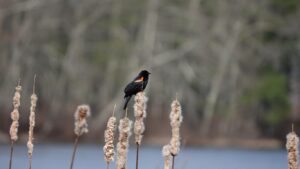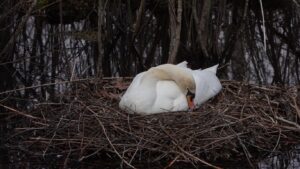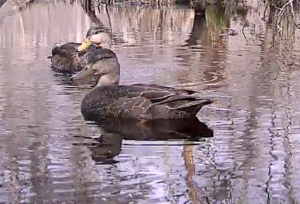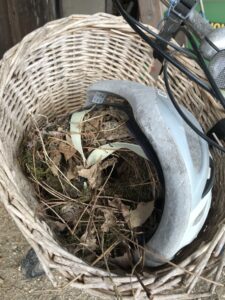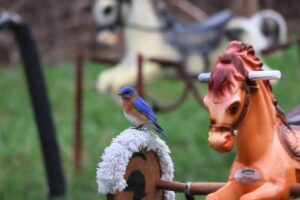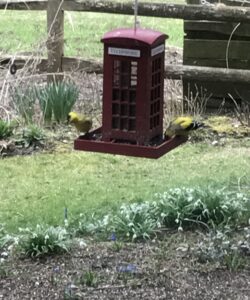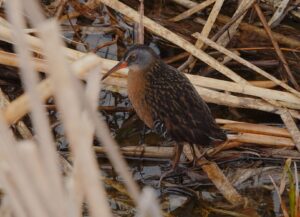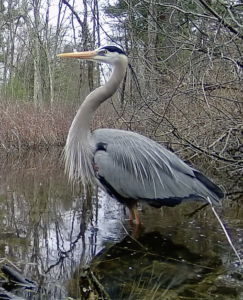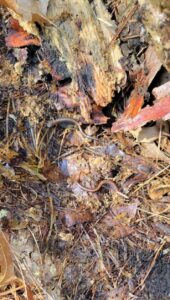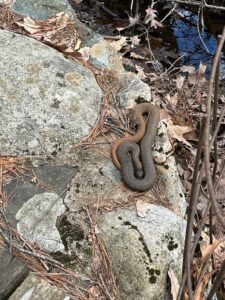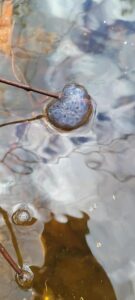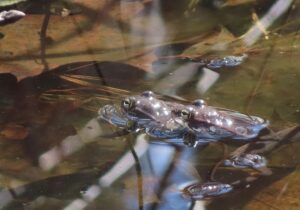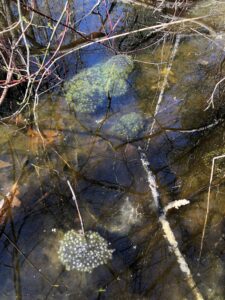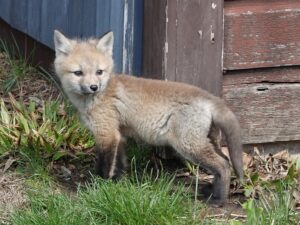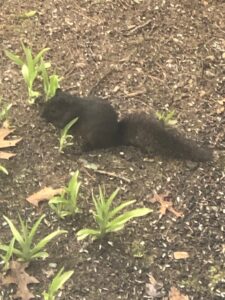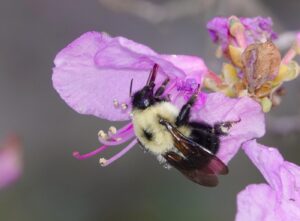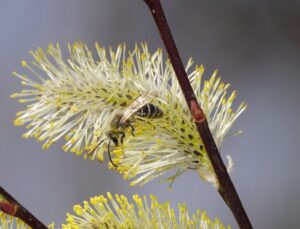Written by Gwyn Loud for the Lincoln Land Conservation Trust. She welcomes your sightings and questions at 781-259-8690 or gwynloud555@gmail.com
If April showers bring May flowers, we should have plenty of flowers, as New England has had rainfall totals five to ten inches higher than average for this time of year, causing the ground to be saturated and streams and ponds to be full or flooding. Our weather over the past month has shown wide swings, from below freezing at night, snow, wind and hail in a nor’easter on April 3-4, to some balmy get-out-the shorts-and-tee-shirts days sprinkled in the mix. Looking at the big picture, the Earth just experienced its hottest March on record, the tenth month in a row to receive this unwelcome distinction. To quote an article in the Washington Post, “Fueled by a mix of human-caused warming and the El Niño climate pattern, the all-time monthly highs were observed both in the air and in the ocean’s waters, the Copernicus report said. The heat over the past 12 months has pushed global average temperatures to an unprecedented 1.58 degrees Celsius (2.84 degrees Fahrenheit) warmer than preindustrial levels, and the hotter air over the Atlantic Ocean in particular could lead to an especially intense hurricane season, scientists warned.”
We had an unusual terrestrial event on April 5, an earthquake! The 4.7 magnitude quake was centered in New Jersey, but tremors were felt in New England, and a few people posted about them on LincolnTalk. I noticed that a huge rock fell off an ancient stone wall and rolled down a slope behind my house that day. Could it have been nudged by the quake? I’ll never know. John Ebel, a professor at Boston College and senior research scientist at the Weston Observatory, said, ”This is a once-in-20-year earthquake here in the northeastern part of the country,” adding it’s a reminder that “we do live in an area that’s prone to earthquakes and very, very, very occasionally has a large, damaging earthquake, as we have had in the past.”
Looking skyward, we had another unusual event, a solar eclipse on April 8. I ventured to northern Vermont to witness totality but Lincolnites who stayed home were treated to about 92% totality on a cloudless day.
Returning our gaze to the local landscape, fields and lawns are beautifully green after all the rain, and the flowering red and silver maples give a reddish cast to the woods. Willows are softly yellow near streams, and around houses forsythia and daffodil provide bursts of gold, with little spots of yellow dandelions in lawns. In April we enjoy the display of flowering magnolias bordering the CCF community gardens. Watch for marsh marigolds to bloom soon along streams.
Non-native shrubs such as honeysuckle and multi-flora rose are among the first to leaf out, which gives them advantages over native shrubs. Quoting an article by researchers at Penn State, “The longer period with leaves gives invasive plants an advantage in acquiring more energy from sunlight and their leaves create shade in early spring and late fall that may limit growth of native species, such as forest ephemeral wildflowers….. This helps explain their negative impact on native tree regeneration, plant diversity and abundance.” See link to full article below. This is also garlic mustard season; it is important to pull it before it sets seeds.
Birds are busy establishing territories and attracting mates, which is why we hear so much bird song at this time of year. While most of the singers are males, ongoing research shows that many female birds around the world sing too. Among our local birds, female cardinals, Baltimore orioles, song sparrows, house finches and red-winged blackbirds also sing, for specific reasons in the breeding cycle. As for pairing, swans, ducks, and geese usually stay with the same mate for life, but our backyard bird pairs are generally together for just one nesting season. Some species molt into brighter colors for breeding and this includes the male American goldfinch. I have enjoyed watching them change into their yellow and black spring feathers at my feeder.
If you watch birds carefully this month you will likely discover where they are nesting. For example, white-breasted nuthatches, black-capped chickadees and tufted titmice dart into holes in trees (often previously made by woodpeckers), and robins or cardinals vanish into shrubs. We probably all have stories of finding nests in odd places. My latest is a Carolina wren nest in my upturned bike helmet (no eggs so far, and I am not biking)! Be sure your bird houses are cleaned out to be welcoming to potential renters such as Eastern bluebirds, tree swallows, or house wrens.
Among recent avian sightings are regular spring arrivals such as Eastern phoebes, swamp sparrows, field sparrows, chipping sparrows, Northern flickers, turkey vultures, gray catbirds, and great blue herons. American woodcocks displayed in many damp fields, including five in the over-flow parking lot at Drumlin Farm! Ducks such as hooded mergansers, wood ducks, green-winged teal, American black ducks, and ring-necked ducks have been seen, and mute swans are nesting on Farrar Pond. Killdeer numbers are increasing, and rusty blackbirds were spotted in the swamp off Old Sudbury Rd. Virginia rails have turned up in several swampy areas. A very unusual sighting was of a ring-necked pheasant, also seen a year ago, on Old Conant Rd. A fish crow, with a distinctive nasal call, hangs out in the big oak across from Lincoln Dog Training at the mall.
Many of our summer avian residents are still migrating north, and it is a perilous journey which some do not survive. Migration primarily happens at night and thousands of birds die when they crash into buildings, attracted by lights. The American Bird Conservancy urges us to “Turn off or dim unnecessary lighting inside and outside. Draw your blinds at night to keep light indoors and shut off decorative lighting outdoors. Make sure any outdoor lighting has a cover above it and aim it downward.” Light pollution is harmful to nocturnal wildlife overall, including to fireflies in their mating season.
Over the next few weeks many of our favorite summer residents such as Baltimore orioles, rose-breasted grosbeaks, and thrushes will arrive. The beautiful wood warblers are on their way north, many just passing through, but several species stay here to breed, including pine warblers, which have already arrived. I always hang my hummingbird feeder out the last week in April, ready for the ruby-throated hummingbirds after their very long journey. Most have flown 500 miles non-stop across the Gulf of Mexico to winter in Mexico or Central America.
The amphibian migration happened in early-mid March over several wet nights rather than one “Big Night”. A sad discovery was of a dead blue-spotted salamander, much rarer than the common spotted salamander which we typically see. The wood frogs’ quacking chorus is over and the adults are headed back to the uplands, leaving the eggs to develop. Spring peepers can be heard any evening giving their chorus from swampy locations, and observers have heard a few pickerel frogs and an early gray-treefrog. Any day now we should hear the high thin trill of the American toads. Redback salamanders are our commonest salamander and forage at night for small invertebrates on the forest floor. They do not lay their eggs in vernal pools. My neighbor found four green frogs in a window well (she helped them out). The only reptile report I received was of a northern water snake, sunning by the skating pond at Mt. Misery on St. Patrick’s Day.
Several people have mentioned seeing foxes, including an especially beautiful one off Weston Rd. The observer wrote that “The fox had black legs and a golden blonde amber body, full puff long orange tail with black and white mixed in and a blonde face.” Fox kits are now old enough to explore out of the den and a gray fox was spotted in the Beaver Pond woods . Other mammals reported include fishers, muskrats, beaver, raccoons, deer, and a melanistic squirrel near Farrar Pond. Chipmunks do not seem as numerous on my property as last year, but time will tell.
The black flies are out! Norm Levey photographed mining bees on willows, and the first bumblebee of the year, which was investigating the Japanese andromeda in the Peace Garden at Lincoln Station. As we start our gardening activities let’s do our best to increase pollinators by planting native plants. They will be available at the LLCT native plant sale on May 18th.
Pertinent Links


